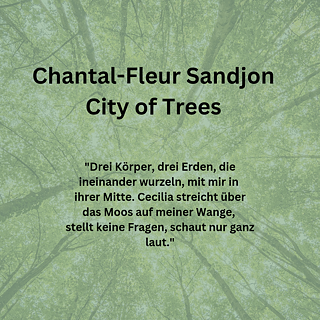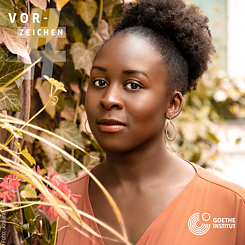Book Review #14
Yeama reads 'City of Trees'
Yeama encounters tender words in Chantal-Fleur Sandjon’s new poetic novel, as capable of piercing the reader through the heart as they are of filling the reader with surprise. Yeama’s newest review for #Vorzeichen investigates how the author abolishes conventional narrative forms.
»I step out of the woods / leaving them there /
the memories of her / her melody / her voice / I return to the world«
These verses allow us to immerse ourselves in the world of protagonist Lindiwe (Lin for short). Because the beautiful words Chantal-Fleur Sandjon chooses for her lyrical novel are tender, simultaneously piercing my heart and filling me with surprise. Sandjon paints the world in impressive images while abolishing narrative conventions.
I encountered a language alternating between prose and verse to locate daring new visualizations of feeling and voice. Realism collides with futuristic elements and African mythology. Markers in the text center Black perspectives. A quote from Octavia E. Butler, for example, introduces the third section of the novel. Lin’s older sister Khanyi disappeared three years before without a trace, and ever since, Lin has been drawn to the forest. She feels close to Khanyi there, blanketing herself in memories. The holes Khanyi has left behind leave rends in the fabric of the family. And then comes her grandmother Gogo and cousin Unathi’s visit from South Africa. Unathi and Lin set out after Khanyi, only to discover their own family’s secrets.
The linguistic violence of the book dissolves boundaries while at the same time making visible the position of in-betweenness: Lin moves between identities, worlds, generations, love, and yearning. Moss grows on her cheek; is she still a person or already one with nature? In the forest, Lin changes more and more, and other strange things begin to happen. More young people disappear, and it becomes clear to the reader that the plants and trees are absorbing more and more of their lives. What is behind the growths flourishing on the bodies of Unathi, Lin, and many others? Is the forest becoming a place of refuge? An exciting and impressive literary experience that lends itself to many different readings.
the memories of her / her melody / her voice / I return to the world«
These verses allow us to immerse ourselves in the world of protagonist Lindiwe (Lin for short). Because the beautiful words Chantal-Fleur Sandjon chooses for her lyrical novel are tender, simultaneously piercing my heart and filling me with surprise. Sandjon paints the world in impressive images while abolishing narrative conventions.
I encountered a language alternating between prose and verse to locate daring new visualizations of feeling and voice. Realism collides with futuristic elements and African mythology. Markers in the text center Black perspectives. A quote from Octavia E. Butler, for example, introduces the third section of the novel. Lin’s older sister Khanyi disappeared three years before without a trace, and ever since, Lin has been drawn to the forest. She feels close to Khanyi there, blanketing herself in memories. The holes Khanyi has left behind leave rends in the fabric of the family. And then comes her grandmother Gogo and cousin Unathi’s visit from South Africa. Unathi and Lin set out after Khanyi, only to discover their own family’s secrets.
The linguistic violence of the book dissolves boundaries while at the same time making visible the position of in-betweenness: Lin moves between identities, worlds, generations, love, and yearning. Moss grows on her cheek; is she still a person or already one with nature? In the forest, Lin changes more and more, and other strange things begin to happen. More young people disappear, and it becomes clear to the reader that the plants and trees are absorbing more and more of their lives. What is behind the growths flourishing on the bodies of Unathi, Lin, and many others? Is the forest becoming a place of refuge? An exciting and impressive literary experience that lends itself to many different readings.



